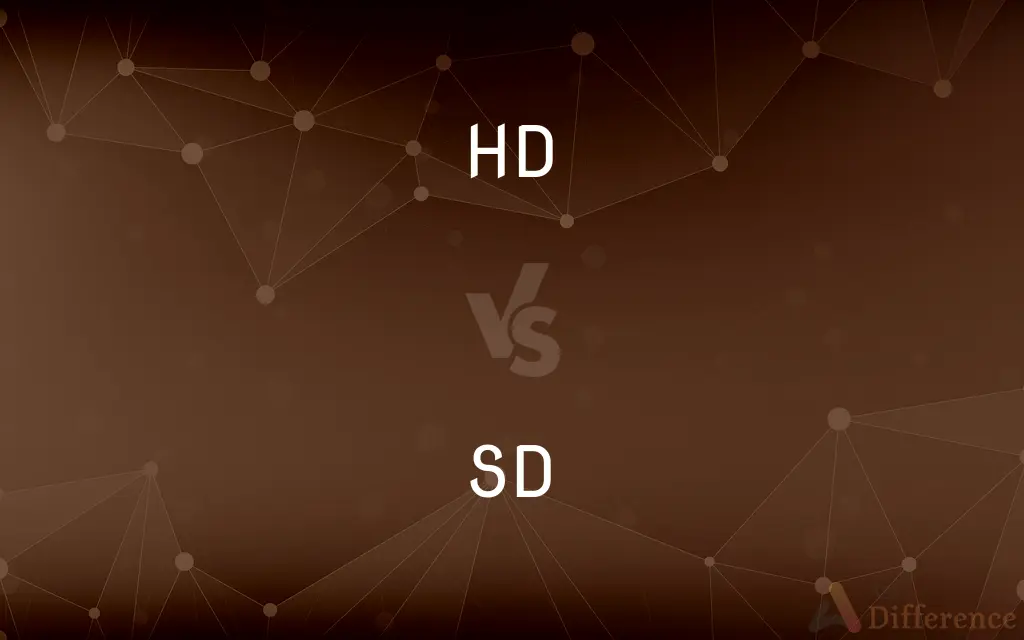HD vs. SD — What's the Difference?
By Tayyaba Rehman — Published on September 27, 2023
HD stands for High Definition, offering clearer and crisper visuals. SD refers to Standard Definition, with lower resolution and less detailed images.

Difference Between HD and SD
Table of Contents
ADVERTISEMENT
Key Differences
HD, or High Definition, provides a resolution that is significantly higher than SD, or Standard Definition.
In HD, the images and videos are clearer, with more details being visible to the viewer. On the other hand, SD delivers content in a resolution that, while satisfactory for many, lacks the depth and clarity of HD.
When a video or image is seen in HD, the viewer can expect a more immersive and true-to-life experience, while SD offers a more basic visual representation.
It's essential to understand that HD requires a higher data bandwidth for transmission than SD, which means that HD content might need faster internet speeds or more storage space.
In contrast, SD content is smaller in file size, making it quicker to download or stream on slower connections. For many, the choice between HD and SD comes down to a trade-off between quality and resource requirements.
ADVERTISEMENT
Comparison Chart
Meaning
High Definition
Standard Definition
Resolution
Higher resolution (e.g., 720p, 1080p).
Lower resolution (e.g., 480p).
Clarity
Clearer, more detailed visuals.
Basic, less detailed visuals.
File Size
Larger due to higher resolution.
Smaller due to lower resolution.
Bandwidth Needs
Requires more bandwidth for streaming.
Requires less bandwidth for streaming.
Compare with Definitions
HD
High-resolution visual content.
The film was available in HD, so the experience was immersive.
SD
Basic clarity in videos or images.
The SD broadcast didn't capture all the nuances of the concert.
HD
Higher pixel count than SD.
The HD display made the photos look lifelike.
SD
A traditional standard for broadcasting.
Old TV shows are often only available in SD.
HD
Enhanced clarity in videos or images.
I prefer watching nature documentaries in HD to appreciate the details.
SD
Lower pixel count than HD.
While the image was SD, it captured the essence beautifully.
HD
A standard for clearer broadcasting.
The sports match was broadcast in HD, capturing every moment.
SD
Digital content with satisfactory visual quality.
SD files are quicker to download due to their smaller size.
HD
Digital content with superior visual quality.
HD streaming requires a good internet connection.
SD
Standard resolution visual content.
The video was in SD, but the content was still enjoyable.
Common Curiosities
What does HD stand for?
HD stands for High Definition.
Why might someone choose SD over HD?
Choosing SD can save bandwidth, storage space, or be suitable for slower internet connections.
Is HD the highest quality available for content?
While HD is of high quality, there are higher resolutions available like 4K and 8K.
Are file sizes larger for HD than SD?
Yes, HD content typically has larger file sizes due to its higher resolution.
Can all devices display HD content?
No, a device needs to support HD resolution to display HD content optimally.
What does SD mean?
SD refers to Standard Definition.
Does HD offer better clarity than SD?
Yes, HD provides clearer and more detailed visuals compared to SD.
Is SD quality unsatisfactory for viewers?
While SD offers less detail than HD, many viewers still find SD content satisfactory, especially on smaller screens.
Do HD and SD refer only to videos?
While commonly associated with video, HD and SD can refer to any visual content, including images.
How do HD and SD impact data usage?
Streaming or downloading HD content generally consumes more data than SD content.
Does watching SD content on an HD screen improve its quality?
Displaying SD content on an HD screen won't increase its inherent quality, but some devices might upscale the content to fit better.
Is there a visible difference between HD and SD on small screens?
On smaller screens, the difference between HD and SD might be less pronounced than on larger displays.
Is the shift from SD to HD noticeable to most viewers?
Many viewers can distinguish between SD and HD due to the increased clarity and detail in HD.
Do streaming platforms charge more for HD?
Some platforms have tiered pricing where HD or higher resolutions come at a premium.
Why is some content only available in SD?
Older content or content produced with lower budgets might only be available in SD due to original recording limitations or decisions.
Share Your Discovery

Previous Comparison
Inc. vs. LLC
Next Comparison
Mommies vs. MummiesAuthor Spotlight
Written by
Tayyaba RehmanTayyaba Rehman is a distinguished writer, currently serving as a primary contributor to askdifference.com. As a researcher in semantics and etymology, Tayyaba's passion for the complexity of languages and their distinctions has found a perfect home on the platform. Tayyaba delves into the intricacies of language, distinguishing between commonly confused words and phrases, thereby providing clarity for readers worldwide.
















































